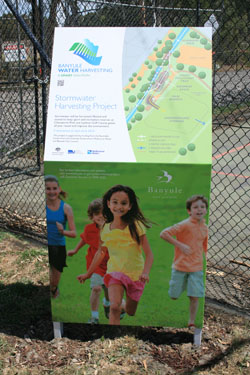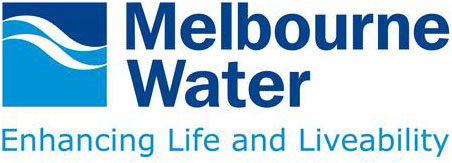resource library
Array
Chelsworth storage with scoria and archway tanks

Kalparrin storage lined and filled with scoria

Chelsworth signage
Banyule Stormwater Harvesting Projects
Banyule City Council
Banyule City Council, Victoria, Australia | Map:
Published: 17 May 2013
Project Overview
Banyule City Council's $6 million Stormwater Harvesting Project captures, treats, and stores stormwater underground to irrigate parks with more sustainable water to benefit the environment and the community.
While sport, recreation and open spaces are important for community health, wellbeing and connection to nature, they account for Council's biggest use of potable water. During times of drought, water restrictions had a significant impact on these areas.
With urbanisation, high volumes of polluted stormwater run-off undermine waterway health. Hundreds of tonnes of litter and other pollution flow into Banyule creeks and rivers.
To address these water sustainability challenges, Banyule is harvesting and treating stormwater at three locations for irrigation of a range of parks and open space. Stormwater harvested at Kalparrin Lake will irrigate Partingtons Flat, Whatmough and Greensborough Parks in Greensborough.
In Ivanhoe, stormwater from Chelsworth Park will irrigate Ivanhoe public golf course and Chelsworth Park, while DeWinton Park stormwater will irrigate the oval in Rosanna.
Stormwater treatment will include water sensitive urban design features such as gross pollutant traps, sedimentation basins, wetlands, raingardens and storages containing scoria and plastic media. A bioactive film on the scoria further contributes to the removal of nitrogen and phosphorus. After these passive components, sand filters and ultra-violet disinfection further clean the water for irrigation use.
The harvesting systems feature large underground storages which mean little open space is lost. Kalparrin also features a 'double-decker' design with a wetland and treatment zone located on top of the storage.
Drivers and Objectives
The project aims to deliver the following benefits:
- Sustainable water supply for the irrigation of a range of sports grounds - savings on potable water consumption
- Improved waterway health and habitat for local wildlife for the parks, Reedy Billabong, Kalparrin Lake and the Plenty and Yarra Rivers;
- Limit the use of premium above-ground space in this constrained urban environment
- Improved community understanding of water sustainability through demonstration of the project and further community engagement; and
- Improved community health and well-being through support of green infrastructure.
Organisations
- Banyule City Council (Responsible council)
- Federal Department of Sustainability & Environment, Water, Population and Communities (Funding partner)
- Federal department of Environment and Primary Industries (Funding partner)
- Melbourne Water (Funding partner)
- Fisher & Fisher (Design consultant)
- Entracon, 2Construct, Evergreen (Construction contractors)
Project Outcomes
Modelling shows that up to 138 million litres of stormwater can be harvested annually, valued at more than $300,000 and substituting the use of potable water;
Annual pollutant removal modelled in MUSIC predicts 70 tonnes of litter, 180 tonnes of sediment, 1 tonne of nitrogen and 250 kilograms of phosphorous;
Innovative solutions including a 'double-decker' design (wetland and treatment zone located on top of storage area) to reduce the footprint of the project to a minimum;
As the first stormwater harvesting project for Banyule, it improved capacity for Council to implement such large and complex projects.
Lessons Learnt
A significant project issue that Council had to work through is how to accurately estimate project costs in a timely manner. This was a very difficult task for Council and the design consultants because of the project size.
A lesson learnt from this experience is that project design and determining cost through tendering are closely linked processes that should be done early in a project timeline. Design and costing helps set key details that are preferable to have bedded down prior to setting funding timelines and other project processes.
The expense of such projects is still relatively unaffordable for Councils such as Banyule in the absence of external funding from the likes of State and Federal Governments.
It was very important to keep the community engaged early on for such a large project, in particular during the construction phase. Council distributed fact sheets to inform and educate the community about the project and its milestones.
Project Cost
Overall capital costs:
- $1.9 million for Kalparrin,
- $3 million for Chelsworth and
- $1.1 million for DeWinton
- Maintenance and other ongoing costs are estimated at about $100,000 per year.
Timeframe
2011-2012: Detailed design, securing funding and other work
2012: Tendering
2013: Construction and completion
Contact
Environmental Sustainability Team
Banyule City Council
T 03 9490 4222
